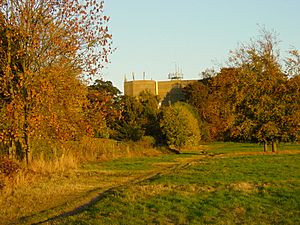Siward's Howe facts for kids
Siward's Howe, also called Siwards How, Heslington Hill, or Bunny Hill, is a special type of hill found near the city of York in England. It's known as a terminal moraine, which means it was formed by a glacier long, long ago.
This interesting hill is located to the south-east of York. You can find it just north-west of the Morrell Library at the University of York. Part of its southern side even belongs to Alcuin college, which is also part of the university. A tall water tower sits on top of Siward's Howe, and you can see it from many nearby areas like Tang Hall and Osbaldwick.
Contents
What is a Howe?
The word "howe" comes from an old language called Old Norse. In Old Norse, the word haugr means a hill, a small mound, or a knoll. Sometimes, it can even refer to an ancient burial mound, also known as a tumulus or barrow. So, Siward's Howe is basically "Siward's Hill."
Who Was Siward?
Siward's Howe is named after a famous warrior from the 11th century named Siward, Earl of Northumbria. He was a powerful Danish warrior who lived a long time ago.
Siward's Story
Siward was a very important figure in English history. He was even featured in William Shakespeare's famous play, The Tragedy of Macbeth. In the play, Siward helps to defeat the evil King Macbeth.
Siward died in York in the year 1055. There's a rumor that he might be buried right on top of Siward's Howe, under the trees at its highest point. This makes the hill even more mysterious and interesting!
How Was Siward's Howe Formed?
Siward's Howe is a type of landform called a terminal moraine. Imagine a giant river of ice, called a glacier, slowly moving across the land. As it moves, it picks up rocks, soil, and other debris.
Glacial Formation
When a glacier melts and stops moving, it leaves behind all the material it carried. A terminal moraine is like a big pile of this rocky and sandy debris that gets pushed up at the very end, or "terminus," of the glacier. So, Siward's Howe is a natural monument left behind by an ancient ice age.
Images for kids





